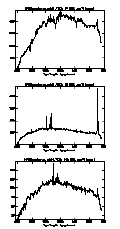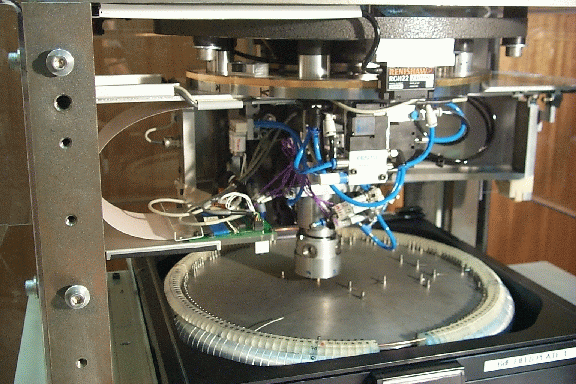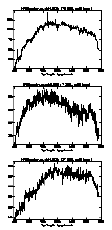

[ROE home page] [WFAU] [6dF form] [IfA] [ATC] [UKST home page] [AAO home page] [2MASS home page] [Search]
![]()



![]()
 Summary
Summary  Principal features of 6dF
Principal features of 6dF  The 6dF K-selected redshift survey
The 6dF K-selected redshift survey  The 6dF peculiar velocity survey
The 6dF peculiar velocity survey  The roles of the AAO and WFAU
The roles of the AAO and WFAU  Other uses of 6dF
Other uses of 6dF  Expected 6dF performance
Expected 6dF performance 
 Applying for 6dF time
Applying for 6dF time  6dF Powerpoint
presentation given at SAAO, June 2000.
6dF Powerpoint
presentation given at SAAO, June 2000. ![]()
![]()
A rendered solid of the 6dF fibre positioner is shown here in Figure.1a while the completed robot assembly in-situ in the new 6dF enclosure in the UKST dome is given here in Figure.1b . Note the new 6dF field plate sitting underneath the r-theta robot itself.
The robot's r and theta motions are servo controlled and carry a pneumatically actuated gripper. The field plate has a curved steel surface, matching the telescope focal surface on which the robot places magnetic buttons. The buttons carry light collecting prisms attached to optical fibres in a 10m cable that directly feeds a spectrograph on the dome floor. This provides an inherently stable instrumental configuration. The 6dF field plates also carry the fibre retractors, a grid of illuminated fiducial marks to establish the positioner coordinate system and a plate rotator to compensate for the rotational offset in the telescope.
A schematic of the 6dF field plate is shown here in Figure.2a while a photograph of one of the two completed 6dF field plates is shown surrounded by its associated 10m of fibre cabling in Figure.2b.
The two interchangeable field plates, each with 150 target fibres, allow one to be configured while the other is on the telescope. Each 6dF field plate is loaded into the telescope in a similar way to photographic plates. Up to 5 fields can be observed per night which enables full-hemisphere spectroscopic survey projects to be tackled for the first time with up to 750 spectra per night.
The 150-fibre cable from each field plate is relayed to an optical bench housing a schmidt-type spectrograph on the dome floor. 6dF currently has 3 dedicated gratings: 250B, 600V and 1200B but the type are exactly the same as used by 2dF so the full range of 2dF gratings are also in principle available. Resolutions range from 1 to 4 A/pixel.
6dF is a direct analogue of the 2dF system on the AAT and provides an excellent statistical survey facility for moderately faint objects (the limit for galaxy redshifts is around B=18) over very wide fields.
![]()
The 6dF galaxy redshift survey is a competitive whole southern sky redshift/peculiar velocity survey based on NIR selection from 2MASS and DENIS data. The unique aspects of this survey were the prime reason that 6dF was approved. A detailed survey implementation plan is being developed to ensure that the principal science goals are met. Up to 75% of UKST time has been allocated to the 6dF redshift survey.
An example of what a cleaned 6dF image frame of 150 galaxy spectra would look like
is shown here in Figure.3.
Wavelength increases to
the right and each row is a galaxy spectrum. Example consecutive galaxy spectra with
B<17.1 from the previous FLAIR system are shown too in
Figure.4.
6dF spectra are expected to probe slightly deeper at a given S/N cf FLAIR due to the
improved DQE and lower Read-out noise (RON) of the new CCD, higher fibre
transmission (from a new Hereaus preform) and better optical aligmment/tolerances in
the fully engineered 6dF positioner.
The K-band is closely related to the old stellar population luminosity and hence galaxy mass whilst minimising both internal and external extinction. It is also un-biased wrt recent star formation. The photometric properties of a subset of the target sample are given here in Figure.5. for both J-K and B-K which shows the additional objects included by the J<13 selection. Histograms of the sample distribution in B and R are given here in Figure.6.
A Science Advisory Group (6dFSAG) has been set-up by the AAT board to provide scientific leadership and direction for the survey, to advise the board of progress and to formulate a detailed implementation plan for the redshift survey.
Further details on the role of the 6dFSAG and associated public domain documentation can be found here
![]()
The primary goal of the second phase of the 6dF survey is to measure peculiar velocities over the entire southern sky. 2MASS and DENIS photometry will be combined with the observed velocity dispersions for a subset of 15,000 early type galaxies with V<15,000Km/s to obtain D_n-sigma distances. This phase should be complete by 2004/2005.
Both survey components will be non-proprietorial and 6dF will also operate as a common user instrument on the UKST. The pipeline data reduction software will be based on the AAT's 2dfdr reduction package to which the 6dF system is directly analogous. A Science Advisory Group (6dFSAG) has been set-up by the AAT board to provide scientific leadership and direction for the survey, to advise the board of progress and to formulate a detailed implementation plan for the redshift survey.
![]()
Agreement has been reached between the AAO and IfA Wide-field Astronomy Unit (WFAU) on the respective general areas of responsibility in the delivery of the 6dF survey data products
![]()
Although for the first few years 6dF will concentrate on the main galaxy redshift survey the system is nevertheless a common user facility with up to 50-60 nights reserved for non-survey projects each year (25-30 nights per semester as for the current FLAIR system). Furthermore, once the main 6dF survey is complete, there is ample scope for alternative large-scale survey projects. For source densities of 5-50 per sq.deg and magnitudes B < 19, 6dF is at least as fast as any current telescope and is likely to remain competitive for some time. A schematic diagram demonstrating the effectiveness of 6dF for undertaking large area large number spectroscopic surveys is shown here in Figure.7. by comparing completion times for the K-selected redshift survey with other MOS systems.
![]()
Once 6dF has been fully commissioned full performance characteristics will be made available. In the meantime some indication of what can be minimally expected can be found by reference to the FLAIR performance characteristics found here
A new CCD and controller have been implemented with 6dF to replace the rather old and difficult to maintain FLAIR CCD system. The new device is a Marconi (EEV) CCD47-10-BI detector. It has 13micron pixels with a 1Kx1K format. It is a thinned, back-illuminated CCD with an astronomy Broad-Band coating. The actual CCD dimensions are 1056x1027 pixels. The chip has excellent cosmetics and high DQE. Further details of this basic type of CCD are given here.
Under a special contract with Mount Stromlo a new controller and CICADA operating system were provided with the new CCD. Full details re the 6dF version of CICADA can be found here, whilst the MSSSO report on the detector performance in the CCD camera assembly can be found here.
Data on some of the gratings are given below:
Grating Blaze Reciprocal Instrumental CCD CCD Spectral
direction dispersion resolution binning resolution range
(A/mm) (A) (A/pixel) (A)
250B collim 286 11.3 x1 3.7 3790
600V collim 122 4.5 x1 1.6 1638
1200B collim 62 2.1 x1 0.8 820
Note that the CCD resolution and spectral range values are only provisional pending
the results from general 6dF commissioning. The AAO grating efficiency curves
can be found
HERE
![]()
 Applying for 6dF time
Applying for 6dF timePlease now refer to the AAO .
![]()
As of Semester 00B FLAIR is now longer available on the UKST due to the need to prepare for the commissioning of 6dF. However links to the old FLAIR www pages and doucmentation are retained for the time being.
Detailed FLAIR information from the AAO
![]()
![]()
e-mail: qap@roe.ac.uk
Last revision: 17th March 2001
![]()